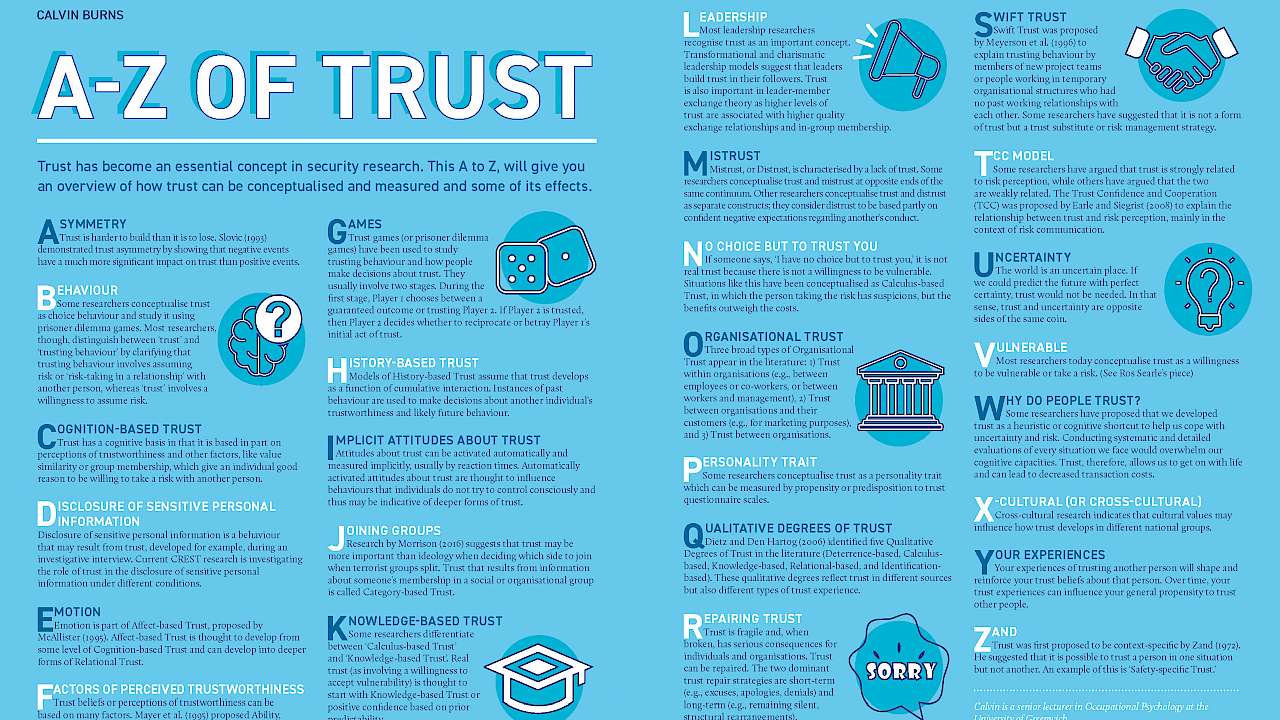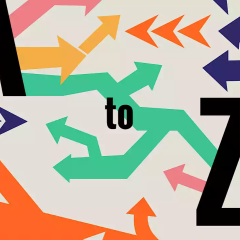Trust has become an essential concept in security research. This A to Z provides an overview of how trust can be conceptualised, measured and influential in shaping behaviour.
Asymmetry
Trust is harder to build than it is to lose. Slovic (1993) demonstrated trust asymmetry by showing that negative events have a much more significant impact on trust than positive events.
Behaviour
Some researchers conceptualise trust as choice behaviour and study it using prisoner dilemma games. Most researchers, though, distinguish between ‘trust’ and ‘trusting behaviour’ by clarifying that trusting behaviour involves assuming risk or ‘risk-taking in a relationship’ with another person, whereas ‘trust’ involves a willingness to assume risk.
Cognition-based Trust
Trust has a cognitive basis in that it is based in part on perceptions of trustworthiness and other factors, like value similarity or group membership, which give an individual good reason to be willing to take a risk with another person.
Disclosure of sensitive personal information
Disclosure of sensitive personal information is a behaviour that may result from trust, developed for example, during an investigative interview. Current CREST research is investigating the role of trust in the disclosure of sensitive personal information under different conditions.
Emotion
Emotion is part of Affect-based Trust, proposed by McAllister (1995). Affect-based Trust is thought to develop from some level of Cognition-based Trust and can develop into deeper forms of Relational Trust.
Factors of perceived trustworthiness
Trust beliefs or perceptions of trustworthiness can be based on many factors. Mayer et al. (1995) proposed Ability, Benevolence, and Integrity as three factors that can account for most of the variability in perceptions of trustworthiness.
Games
Trust games (or prisoner dilemma games) have been used to study trusting behaviour and how people make decisions about trust. They usually involve two stages. During the first stage, Player 1 chooses between a guaranteed outcome or trusting Player 2. If Player 2 is trusted, then Player 2 decides whether to reciprocate or betray Player 1’s initial act of trust.
History-based Trust
Models of History-based Trust assume that trust develops as a function of cumulative interaction. Instances of past behaviour are used to make decisions about another individual’s trustworthiness and likely future behaviour.
Implicit attitudes about trust
Attitudes about trust can be activated automatically and measured implicitly, usually by reaction times. Automatically activated attitudes about trust are thought to influence behaviours that individuals do not try to control consciously and thus may be indicative of deeper forms of trust.
Joining groups
Research by Morrison (2016) suggests that trust may be more important than ideology when deciding which side to join when terrorist groups split. Trust that results from information about someone’s membership in a social or organisational group is called Category-based Trust.
Knowledge-based Trust
Some researchers differentiate between ‘Calculus-based Trust’ and ‘Knowledge-based Trust’. Real trust (as involving a willingness to accept vulnerability) is thought to start with Knowledge-based Trust or positive confidence based on prior predictability.
Leadership
Most leadership researchers recognise trust as an important concept. Transformational and charismatic leadership models suggest that leaders build trust in their followers. Trust is also important in leader-member exchange theory as higher levels of trust are associated with higher quality exchange relationships and in-group membership.
Mistrust
Mistrust, or Distrust, is characterised by a lack of trust. Some researchers conceptualise trust and mistrust at opposite ends of the same continuum. Other researchers conceptualise trust and distrust as separate constructs; they consider distrust to be based partly on confident negative expectations regarding another’s conduct.
No choice but to trust you
If someone says, ‘I have no choice but to trust you,’ it is not real trust because there is not a willingness to be vulnerable. Situations like this have been conceptualised as Calculus-based Trust, in which the person taking the risk has suspicions, but the benefits outweigh the costs.
Organisational Trust
Three broad types of Organisational Trust appear in the literature: 1) Trust within organisations (e.g., between employees or co-workers, or between workers and management), 2) Trust between organisations and their customers (e.g., for marketing purposes), and 3) Trust between organisations.
Personality trait
Some researchers conceptualise trust as a personality trait which can be measured by propensity or predisposition to trust questionnaire scales.
Qualitative degrees of trust
Dietz and Den Hartog (2006) identified five Qualitative Degrees of Trust in the literature (Deterrence-based, Calculus-based, Knowledge-based, Relational-based, and Identification-based). These qualitative degrees reflect trust in different sources but also different types of trust experience.
Repairing Trust
Trust is fragile and, when broken, has serious consequences for individuals and organisations. Trust can be repaired. The two dominant trust repair strategies are short-term (e.g., excuses, apologies, denials) and long-term (e.g., remaining silent, structural rearrangements).
Swift Trust
Swift Trust was proposed by Meyerson et al. (1996) to explain trusting behaviour by members of new project teams or people working in temporary organisational structures who had no past working relationships with each other. Some researchers have suggested that it is not a form of trust but a trust substitute or risk management strategy.
TCC model
Some researchers have argued that trust is strongly related to risk perception, while others have argued that the two are weakly related. The Trust Confidence and Cooperation (TCC) was proposed by Earle and Siegrist (2008) to explain the relationship between trust and risk perception, mainly in the context of risk communication.
Uncertainty
The world is an uncertain place. If we could predict the future with perfect certainty, trust would not be needed. In that sense, trust and uncertainty are opposite sides of the same coin.
Vulnerable
Most researchers today conceptualise trust as a willingness to be vulnerable or take a risk. (See Ros Searle’s piece)
Why do people trust?
Some researchers have proposed that we developed trust as a heuristic or cognitive shortcut to help us cope with uncertainty and risk. Conducting systematic and detailed evaluations of every situation we face would overwhelm our cognitive capacities. Trust, therefore, allows us to get on with life and can lead to decreased transaction costs.
XCultural (or Cross-Cultural)
Cross-cultural research indicates that cultural values may influence how trust develops in different national groups.
Your experiences
Your experiences of trusting another person will shape and reinforce your trust beliefs about that person. Over time, your trust experiences can influence your general propensity to trust other people.
Zand
Trust was first proposed to be context-specific by Zand (1972). He suggested that it is possible to trust a person in one situation but not another. An example of this is ‘Safety-specific Trust.’
Calvin Burns is a senior lecturer in occupational psychology at the University of Greenwich.
Read more
- Berg, J., Dickhaut, J., & McCabe, K. (1995). Trust, reciprocity, and social history. Games and Economic Behavior 10, 123, 122-143. https://bit.ly/3bNVhjz
- Burns, C., & Conchie, S. M. (2011). Measuring implicit trust and automatic attitude activation. In F. Lyon, G. Mollering, & M. Saunders (Eds.) Handbook of Research Methods on Trust. Edward Elgar, London.
- Dietz, G., & Den Hartog, D. N. (2006). Measuring trust inside organisations. Personnel Review, 35, 557-588. https://bit.ly/3af8rG1
- Earle, T. C., & Siegrist, M. (2008). Trust, Confidence and Cooperation Model: A framework for understanding the relation between trust and Risk Perception. International Journal of Global Environmental Issues, 8, 17-29. https://bit.ly/3AvfAwA
- Ferrin, D. L., & Gillespie, N. A. (2009, June). Cultural differences and universals in the development of trust. In 22nd Annual IACM Conference Paper. https://bit.ly/3Ij0VGA
- Lewicki, R. J., McAllister, D. J., & Bies, R. J. (1998). Trust and Distrust: New relationships and realities. Academy of Management Review, 23, 438-458. https://bit.ly/3RiBSYu
- McAllister, D. J. (1995). Affect- and Cognition- based trust as foundations for interpersonal cooperation in organizations. Academy of Management Journal, 38, 24-59. https://bit.ly/3OGPrPz
- Meyerson, D., Weick, K. E., & Kramer, R. M. (1996). Swift trust and temporary groups. In R. M. Kramer & T. R. Tyler (Eds.) Trust in Organizations: Frontiers of Theory and Research. Sage, Thousand Oaks.
- Schoorman, D. F., Mayer, R. C. & Davies, J. H. (2007). An integrative model of organizational trust: Past, present and future. Academy of Management Review, 22, 344-354. https://bit.ly/3NJbIuJ
- Slovic, P. (1993). Perceived risk, trust and democracy. Risk Analysis, 13, 675-682. https://bit.ly/3use0Ye
- Zand, D. E. (1972). Trust and Mangerial Problem Solving. Administrative Science Quarterly, 17, 229-239. https://bit.ly/3RbA2bJ
Copyright Information
As part of CREST’s commitment to open access research, this text is available under a Creative Commons BY-NC-SA 4.0 licence. Please refer to our Copyright page for full details.
IMAGE CREDITS: Copyright ©2024 R. Stevens / CREST (CC BY-SA 4.0)





